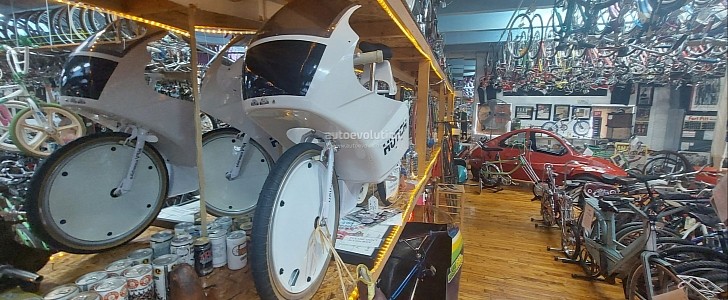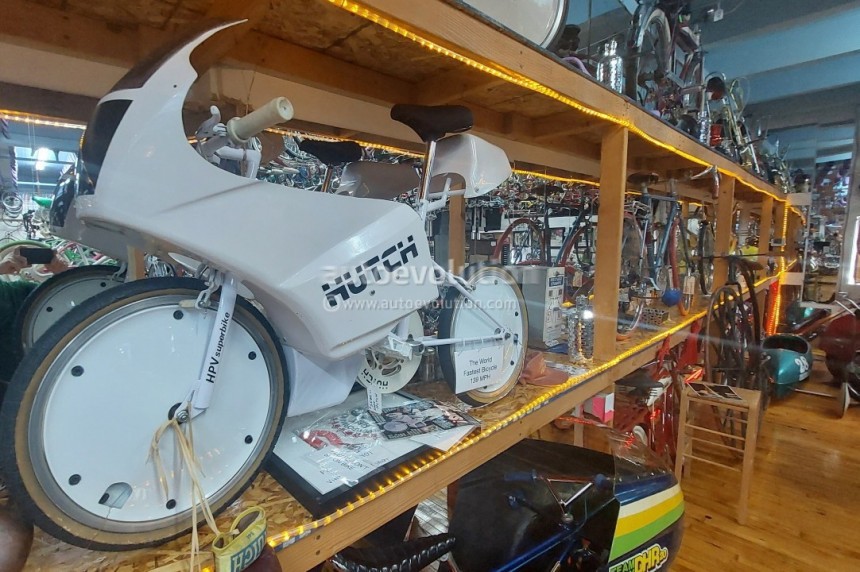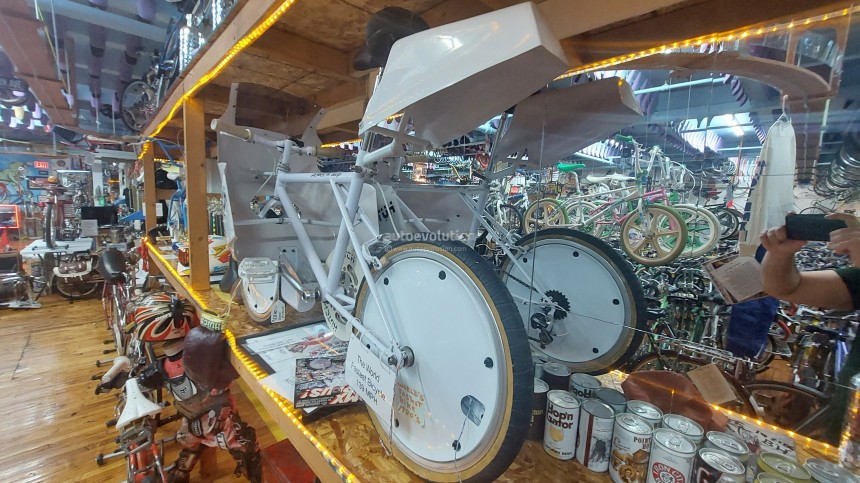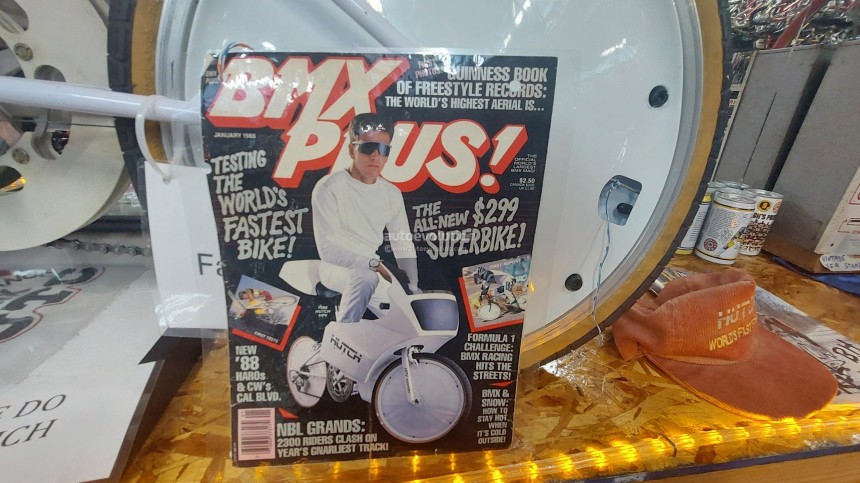We adore all things fast here at autoevolution. But yet, we seem to inevitably reserve most of our love for cars, motorcycles, or the occasional military fighter jet.
But if you're a different type of speed enthusiast, the Bicycle Heaven Museum has something just for you. Ladies and Gentlemen, in the late 80s and early 90s, this Hutch HPV was the world's fastest bicycle. It comes to us via a very public collection based out of Pittsburgh, Pennsylvania, called Bicycle Heaven.
It's one of the largest vintage bicycle collections in North America and possibly even the largest in the entire world, at least according to their advertising. But of all the bikes in Craig and Mindy Morrow's collection, this Hutch HPV has to be the fastest. When walking up to this vintage bike for the first time, it's difficult not to have the impression that it's a motorcycle yet to have its engine installed.
This happens because the full racing fairing shell that makes the bike's front half look like an Isle of Man TT Superbike with the aspect ratio messed up. This front fascia arrangement serves the very same purpose as it would in a racing motorcycle, after all. That being, to cut as clean of a line through high-speed air with as little resistance, or drag, as possible.
Significant advances in our understanding of aerodynamics and its effects at high speed were still somewhat of emerging science in the late 1980s, especially in applications other than airplanes and race cars. So, to see it implemented on a lowly bicycle must have been pretty mind-blowing nearly 35 years ago.
As it happens, the Hutch HPV was designed by a man who turned out to be more ahead of their contemporaries than perhaps he himself may have realized initially. His name was Dan Hanebrink, an engineer for Maryland-based Hutch BMX in the late 80s and early 1990s. His inspiration came while observing a semi-pro competitive cycling race in Irvine, California, sometime before 1988, according to a BMX Action Magazine article on the bike from the period.
Hanebrink carried on developing, testing, and fine-tuning the design for the next 18 months. Knowing all the while, the BMX and off-road trail-focused business model that Huch was famous for at the time would be one heck of a bump in the road. Yet, it's still possible that he himself didn't yet realize it was going to be a record-breaker.
As mentioned, the finished product looked something more like a small racing motorcycle than a human-powered bicycle. But rest assured, there's a heck of a lot more to it than that. Underneath the lightweight plastic was a set of components even most bike enthusiasts would find unusual. Not the least is that there isn't even a handlebar stem.
Instead, an entirely separate piece of metal within the larger frame of the bike is welded in place so that the two become one. From there, the piece was welded to twin forks. At this point, the front wheel, complete with aerodynamic shrowding where the spokes should be, was mounted to create a suspension setup, which an F1 engineer would surely appreciate.
With sprocket sets ranging from 52 to 64 teeth in the front and 12 to 24 in the rear with 12 gears in total, it would take another 30 years before an automobile carried a gearbox with even remotely as many gears. With a total weight around the 30-pound mark (13.6 kg), there's a lot less bulk than one would expect with a bike as imposing and wide as the Hutch HPV.
But with a launch price of $299 for the basic model and $399 for the premium at launch, the Hutch HPV was somewhat of a bargain in its day. But, with a body as slippery and aerodynamic as this, how fast could it really go? Well, going downhill and with a car in front for added slipstream, staff at the Bicycle Heaven Museum peg the top speed of this bike at a scarcely believable 139 miles per hour (223.7 kph).
Of course, under strictly pedal power on a flat surface, it's claimed you could take this up to 40 or so mph (65 kph) if you're really committed. Sadly, the chances of one of these bikes reaching those speeds again are slim to none, largely because they routinely sell for in excess of $4,000 in nice condition. Or at least the cost of one ER visit if you wipe out in one of these.
We found one on sale via Budget Cycle Center online for $4,999 before taxes and shipping fees. So then, at least for a period in the late 80s, the Hutch HPV represented bicycles at the very same table as the McLaren F1, the Kawasaki Ninja, and the SR-71 Blackbird in a sort of "who's who" club of the world's fastest vehicles. It's just one of the 5,000-plus rare and unique bikes in one of the craziest and most varied collections anywhere in the world.
Check back for more from our trip to the world's largest bike museum real soon here on autoevolution.
It's one of the largest vintage bicycle collections in North America and possibly even the largest in the entire world, at least according to their advertising. But of all the bikes in Craig and Mindy Morrow's collection, this Hutch HPV has to be the fastest. When walking up to this vintage bike for the first time, it's difficult not to have the impression that it's a motorcycle yet to have its engine installed.
This happens because the full racing fairing shell that makes the bike's front half look like an Isle of Man TT Superbike with the aspect ratio messed up. This front fascia arrangement serves the very same purpose as it would in a racing motorcycle, after all. That being, to cut as clean of a line through high-speed air with as little resistance, or drag, as possible.
Significant advances in our understanding of aerodynamics and its effects at high speed were still somewhat of emerging science in the late 1980s, especially in applications other than airplanes and race cars. So, to see it implemented on a lowly bicycle must have been pretty mind-blowing nearly 35 years ago.
Hanebrink carried on developing, testing, and fine-tuning the design for the next 18 months. Knowing all the while, the BMX and off-road trail-focused business model that Huch was famous for at the time would be one heck of a bump in the road. Yet, it's still possible that he himself didn't yet realize it was going to be a record-breaker.
As mentioned, the finished product looked something more like a small racing motorcycle than a human-powered bicycle. But rest assured, there's a heck of a lot more to it than that. Underneath the lightweight plastic was a set of components even most bike enthusiasts would find unusual. Not the least is that there isn't even a handlebar stem.
Instead, an entirely separate piece of metal within the larger frame of the bike is welded in place so that the two become one. From there, the piece was welded to twin forks. At this point, the front wheel, complete with aerodynamic shrowding where the spokes should be, was mounted to create a suspension setup, which an F1 engineer would surely appreciate.
But with a launch price of $299 for the basic model and $399 for the premium at launch, the Hutch HPV was somewhat of a bargain in its day. But, with a body as slippery and aerodynamic as this, how fast could it really go? Well, going downhill and with a car in front for added slipstream, staff at the Bicycle Heaven Museum peg the top speed of this bike at a scarcely believable 139 miles per hour (223.7 kph).
Of course, under strictly pedal power on a flat surface, it's claimed you could take this up to 40 or so mph (65 kph) if you're really committed. Sadly, the chances of one of these bikes reaching those speeds again are slim to none, largely because they routinely sell for in excess of $4,000 in nice condition. Or at least the cost of one ER visit if you wipe out in one of these.
We found one on sale via Budget Cycle Center online for $4,999 before taxes and shipping fees. So then, at least for a period in the late 80s, the Hutch HPV represented bicycles at the very same table as the McLaren F1, the Kawasaki Ninja, and the SR-71 Blackbird in a sort of "who's who" club of the world's fastest vehicles. It's just one of the 5,000-plus rare and unique bikes in one of the craziest and most varied collections anywhere in the world.










